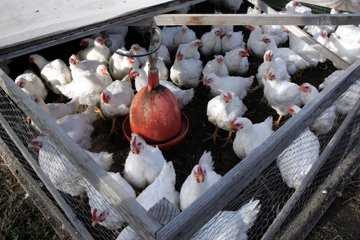
Californians for Humane Farms say industrial farming is hurting
animals
Industrial farming conditions are cruel.
That sentiment is at the heart of a measure being sponsored by
animal rights groups, veterinarians, environmentalists and
others.
Californians for Humane Farms say industrial farming is hurting animals
Industrial farming conditions are cruel.
That sentiment is at the heart of a measure being sponsored by animal rights groups, veterinarians, environmentalists and others.
The group, Californians for Humane Farms, think Californians will agree.
Coalition members are gathering signatures to put a measure on the ballot for the November 2008 election, dubbed the California Prevention of Farm Animal Cruelty Act.
The measure would change the minimum standards for the confinement of egg-laying hens, breeding hogs, and veal calves, according to the measure.
Breeding hogs and veal calves would get enough space to turn around in their crate, according to the measure. Egg-laying hens would get enough room to fully extend their wings without touching their cage or other animals.
“There are nearly 20 million farm animals [in California] who are confined so restrictively for most of their lives that they are barely able to move,” said Paul Shapiro, senior director of the Humane Society factory farming campaign, a sponsor of the group.
In San Benito County, however, few animal farming operations would be affected by the measure, according to Paul Matulich, the county agricultural commissioner.
“I don’t think it would affect anybody in our county,” said Matulich.
None of the egg-laying hens in the County are kept in battery cages, according to Matulich. There is only one pork producer left in the county, at most.
Battery cages batter animals
Egg-laying hens are generally kept in battery cages, Shapiro said. The cages are small wire enclosures that are lined in rows and stacked one on top of the other inside warehouses, according to Farm Sanctuary, an animal rights group that specializes in the protection of farm animals.
Bill Mattos, the president of the California Poultry Federation, a trade organization for poultry producers, opposes the drive for a ballot initiative.
“Basically it’s an unnecessary act,” Mattos said. “Every state in the United States follows best management practice guidelines.”
The size of the battery cage is important in today’s animal husbandry environment, according to Mattos.
But those in favor say the guidelines are not adequate.
“Today’s densities that we’re running right now is about 64 to 68 square inches per bird,” said Mark Bland, a private poultry consultant. He consults with small-to-moderate sized businesses.
On average, hens need at least 144 square inches of space to stretch their wings, according to a study published by the University of California, Davis and Kansas State University.
“Sixty-seven square inches is less space than a single sheet of letter-sized paper,” Shapiro said.
The increased space for birds would come with a cost for consumers, according to advocates and opponents.
Eggs from free-range hens cost between 8 and 59 percent more to produce, Shapiro said. Opponents say the increases could be three to four times that.
Chicken farmer raises healthy hens without cages
One local farmer, Paul Hain, raises free-range hens at a premium He raises broiler hens and egg-laying hens.
“The whole philosophy behind what I’m dong is to eat meat that’s produced in a way that’s best for the animal,” Hain said. “Many parts of the industry don’t see that’s affordable.”
The measure would force egg producers to switch to a cage-free system, according to Joy Mench, professor and director of the Center for Animal Welfare at the University of California, Davis. The problem is making a cage big enough for birds to stretch their wings without touching other birds.
“You could have a big enough cage, but then it wouldn’t be a cage. It would be a pen,” Mench said.
The catch-22 is that cage-free systems can have problems too, according to Mench, who opposes the measure.
“Both these systems have their up and down sides,” Mench said. “These cage-free systems are not without their problems.”
In cage-free systems, birds that come into contact with feces can get intestinal parasites.
Other problems, according to Mench, include broken bones from osteoporosis and cannibalism, which happens in large flocks. Cannibalistic behaviors can include feather pulling, toe pecking, and vent picking in older birds, Mench said. An outbreak of cannibalism in a flock can cause significant injury to the birds.
“Cannibalism indicates that there is something wrong in the environment for the bird,” Mench said.
One way farmers combat cannibalism is beak trimming, Mench said.
“They have a hard time eating when you trim their beaks,” said Hain, who does not trim his birds’ beaks. “If you don’t have stressful situations, you don’t have to trim beaks.”
Hain said his hens are healthier than caged hens and he has not seen any of the problems that Mench warns can plague free-range hens.
“I’m sure they are [healthier,] in the way that we do things organically and naturally, instead of putting them in conditions where they might need antibiotics to survive,” Hain said. “It’s the way nature does it, and well, it’s the way we should be raising our animals.”
Hain attributes the health of his birds to they way they are raised and the smaller size of his flock.
“Just like humans, if you’re standing in a crowded elevator, it makes you do strange things,” Hain said. “It makes the birds do strange things too. But it’s basically stress.”
Paula Kislak, a Santa Barbara veterinarian, is an advocate of the measure.
“I feel it’s a very modest act,” Kislak said. “It is cruel and inhumane to confine animals in such small spaces.”
The measure would also change practices in California’s pork industry. There are about 20,000 breeding hogs in California, according to Shapiro.
Breeding hogs are kept in gestation crates, according to Shapiro. A gestation crate is a pen that “contains the sow in the least possible space that is economically feasible,” according to the Alberta Pork Web site, a trade organization for the pork industry.
“Pigs are very intelligent and they are very sociable,” Kislak said. “Their sociability and intelligence are on par with dogs.”
When crated, breeding hogs exhibit behavior such as repetitive motion with no obvious purpose, according to Kislak.
“They are mind-numbingly bored, and they get stir crazy,” Kislak said. “They bite on the cage just incessantly and they wave their heads back and forth.”
Animals are kept in much smaller enclosures than in the past, Shapiro said.
“This has happened over the last couple of decades without most people being aware of it. This has occurred outside of public view,” Shapiro said. “When people learn what is happening to farm animals today, they are upset and are concerned.”
The coalition kicked off its signature gathering efforts Oct. 1, according to a press release from the Humane Society. Staff and volunteers must gather at least 650,000 signatures by Feb. 28 to qualify.
Opponents of the bill say that consumer education is a better way to change the industry.
Calling the initiative ‘outrageous,’ Mattos said, “The people who are pushing this have no idea how this works. They’d rather we just ate vegetables. Veterinarians, university professors know much more than they do.”
State by state legislation is not an effective way to change the industry, according to Mench.
“There are no trade barriers across states,” Mench said. “All it means is that we’re going to be purchasing more and more out-of-state eggs.”
Scientists need the flexibility to study new systems and adapt them to best fit the birds’ and their handlers’ needs.
“I don’t think we’re ready yet to say, ‘this is the best system, ban everything else,'” Mench said.
Some cage options would be outlawed
One system that is being researched at universities in the United States is a furnished cage system, according to Mench.
Furnished cages are equipped with a nest box, perch, and dust bath, according to Mench. Hens take dust baths to condition their feathers.
“A lot of scientists believe that these cages preserve some of the natural behaviors of hens,” Mench said.
No producers in the nation are currently using furnished cages, but if the measure passed the cages would not meet new requirements.
In 2006 Arizona voters passed a measure similar to the one that Californians for Humane Farms is sponsoring. It passed by 62 percent to 38 percent.
If put on the ballot and approved, the measure would exempt enclosure sizes for state and county fairs, 4-H exhibitions, transportation, treatment by a veterinarian and in the week before slaughter. Exemptions are also available for agricultural and scientific research.
Jessica Ablamsky can be reached at ja*******@**********ws.com.









